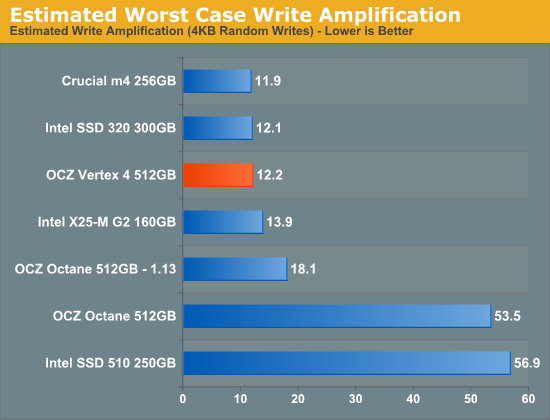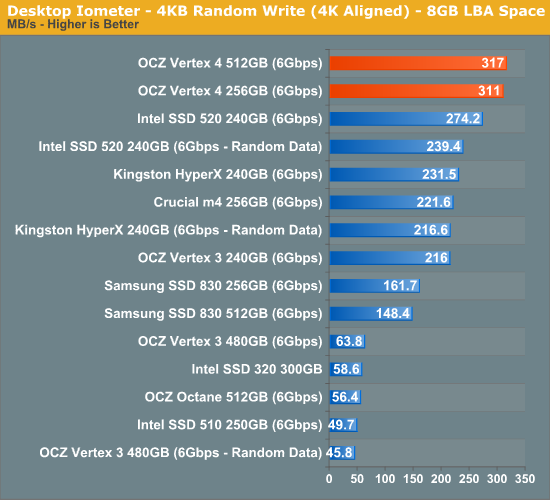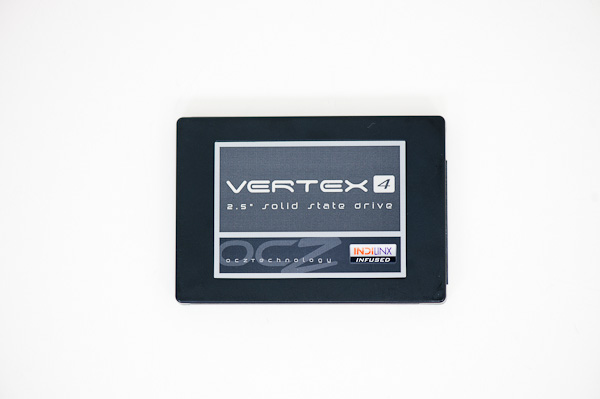OCZ Vertex 4 Review (256GB, 512GB)
by Anand Lal Shimpi on April 4, 2012 9:00 AM ESTThirteen months ago OCZ announced its intention to acquire Indilinx, the SSD controller maker that gave Intel its first taste of competition in the consumer market in 2009. Eight months later, OCZ launched its first post-acquisition SSD based on Indilinx silicon. Today, just five months after the launch of the Octane, OCZ is officially releasing the Vertex 4 – based on its Indilinx Everest 2 silicon. In less than a year, OCZ has brought to market more Indilinx powered controllers than Indilinx did in the previous three years. It's rare that you see the fruits of acquisition so quickly, but if there's anything OCZ's CEO Ryan Petersen is good at it's pushing for an aggressive schedule.
Rather than call this drive the Octane 2, OCZ went with Vertex 4, indicating its rightful place at the top of OCZ's SSD lineup. The implications run even deeper. It marks the first time in two years that a Vertex drive will ship without a SandForce controller inside. Make no mistake, while Octane was a shot across SandForce's bow, Vertex 4 means war. While OCZ continues to ship tons of SandForce controllers, the future for the company is Indilinx. The Vertex 4 is just the beginning. OCZ will continue to ship Vertex 3 in parallel, and should a future SandForce controller make competitive sense to use OCZ will definitely consider it, but the intention is to build the fastest silicon internally and use it as much as possible.
The dramatic departure in naming also embodies just how different Everest 2 is from the original Everest controller. OCZ claims there's minimal shared code between the Octane and Vertex 4 firmware, and the two drives perform very differently. Write amplification was always a concern with the Octane - it is no longer a major issue with the Vertex 4. OCZ and its Indilinx team have reduced write amplification to roughly the levels of Intel's controllers:

Indeed write performance is improved significantly as a result. A look at the spec sheet gives us the first indication of what's to come:
| OCZ SSD Comparison | ||||||
| OCZ Vertex 4 | OCZ Vertex 3 | OCZ Octane | OCZ Vertex 2 | |||
| Current NAND | 25nm IMFT MLC | 25nm IMFT MLC | 25nm IMFT MLC | 25nm IMFT MLC | ||
| Capacities | 128, 256, 512GB | 60, 90, 120, 240, 480GB | 128, 256, 512GB, 1TB | 60, 120, 240GB | ||
| Controller | Indilinx Everest 2 | SF-2281 | Indilinx Everest | SF-1221 | ||
| Max Seq Read | 535 MB/s | 550 MB/s | 480 MB/s | 285 MB/s | ||
| Max Seq Write | 475 MB/s | 500 MB/s | 330 MB/s | 275 MB/s | ||
| Max Random Read | 95K IOPS | 60K IOPS | 26K IOPS | - | ||
| Max Random Write | 85K IOPS | 85K IOPS | 35K IOPS | 50K IOPS | ||
| AES-256 Encryption | Yes | Yes | Yes | No | ||
Regardless of the nature of the data (compressible or incompressible), the Everest 2 powered Vertex 4 promises better random write performance than any other consumer SSD on the market today. And it delivers:

Random write speed is nothing short of incredible. OCZ is able to equal SandForce's write speed on highly compressible data without resorting to any sort of data compression. This is a purely algorithmic advantage. While the original Everest was a work in progress by the time OCZ acquired the company, Everest 2 is the first Indilinx project OCZ had complete control over. Apparently OCZ's CEO, Ryan Petersen had a lot of his own input built into this design.
| OCZ Vertex 4 Lineup | |||||
| 512GB | 256GB | 128GB | |||
| NAND Configuration | 16 x 32GB 25nm Intel sync NAND | 16 x 16GB 25nm Intel sync NAND | 8 x 16GB 25nm Intel sync NAND | ||
| DRAM | 2 x 512MB DDR3-800 | 2 x 512MB DDR3-800* |
2 x 512MB DDR3-800* | ||
| Controller | Indilinx Everest 2 | Indilinx Everest 2 | Indilinx Everest 2 | ||
| Max Seq Read | 535 MB/s | 535 MB/s | 535 MB/s | ||
| Max Seq Write | 475 MB/s | 380 MB/s | 200 MB/s | ||
| Max Random Read | 95K IOPS | 90K IOPS | 90K IOPS | ||
| Max Random Write | 85K IOPS | 85K IOPS | 85K IOPS | ||
| MSRP | $699 | $349 | $179 | ||
The Vertex 4 will be available in three capacities initially – 128GB, 256GB and 512GB, with a 1TB version following. Drives should be available today but in very limited quantities, and likely only 128GB capacities at the start. MSRP is fairly competitive with other 6Gbps drives on the market today:
| SSD Pricing Comparison | |||||
| 128GB | 256GB | 512GB | |||
| Crucial m4 | $154.99 | $299.99 | $549.99 | ||
| Intel SSD 520 | $184.99 | $344.99 | $799.99 | ||
| Samsung SSD 830 | $174.99 | $299.99 | $779.99 | ||
| OCZ Octane | $199.99 | $339.99 | $849.99 | ||
| OCZ Vertex 3 | $199.99 | $339.99 | $1199.99 | ||
| OCZ Vertex 4 | $179 MSRP | $349 MSRP | $699 MSRP | ||











127 Comments
View All Comments
RussianSensation - Wednesday, April 4, 2012 - link
It seems after extensive use and degradation, the Corsair Performance Pro is one of the best, even besting the Crucial M4:http://www.xbitlabs.com/articles/storage/display/m...
meloz - Wednesday, April 4, 2012 - link
What's the deal with using such an enormous SoC built on 65nm process?I can understand OCZ / Indilinx not willing to shell premium for cutting edge 28nm process, but they could have at least used 45nm process.
With a 45nm process the SoC would be a lot smaller, thermal management would be easier (and cheaper), and power consumption would be lower (firmware update or not).
The cost of more modern process is easily balanced by the fact that they would get a lot more chips of a 300nm wafer with 45nm rather than 65nm.
Vertex 4 is a good improvement from OCZ, but they need to get serious about their execution and 'little details' if they still want to exist in another 5 years. Marvell, SandForce and Intel are not standing still and as competition increases the price of such poor decisions will weigh heavily against OCZ.
Ryan Smith - Thursday, April 5, 2012 - link
While we obviously can't speak for OCZ, when it comes to processes do keep in mind that costs escalate with the process. Older processes are not only cheaper because they have effectively reached their maximum yields, but the cost of their development has always been paid off, allowing the fabs to sell wafer runs at a lower cost and still book a profit.For a sufficiently simple device, the additional number of dice per wafer may not offset the higher per-wafer costs, lower yield, and demand-driven pricing. 4x nm processes are still booked solid, and will be for some time.
NCM - Wednesday, April 4, 2012 - link
Firmware "promises" aren't worth the guarantee they're not written on.We buy today's product, not the product there might be in some indefinite future.
rw1986 - Wednesday, April 4, 2012 - link
seems intel NAND would cost more and OCZ buys most of their NAND from Micron I believeKristian Vättö - Wednesday, April 4, 2012 - link
Without knowing the prices, it's hard to say anything. Intel and Micron NAND come from the same fab so the silicon quality is the same. Intel does rate their NAND higher (5000 vs 3000 P/E cycles) and both companies have their own validation processes, so it's possible that Intel NAND is slightly higher quality.It's possible that OCZ sources NAND from several fabs for the Vertex 4. E.g. Vertex 3 used NAND from Intel, Micron, Spectec and Hynix. Micron NAND is available in higher quantity as they own more plants, so that's why it's more common. Price wise I guess they are all about the same, though.
bji - Wednesday, April 4, 2012 - link
Any time a drive has a significant amount of RAM in it, I get a bit worried about the possibility of data loss on power outage. If the drive has the name OCZ attached, this worry becomes a huge concern. I would not be at all surprised if OCZ increased performance in part by reducing durability in the face of power outage.If the RAM is used as a write buffer, then on power outage the data is lost. This is not a problem if the drive correctly reports this state to the operating system - i.e., not telling the operating system that the data is sync'd to permanent storage until it's been written out of RAM cache into the flash cells. But if the drive cheats by telling the operating system that the blocks have been written when they have been stored in its RAM rather than when the blocks have actually made it to the flash cells, then data can be lost despite the guarantee that the drive has given that it can't.
Cheating in this way could make write performance look better, and given that the drive looks particularly good for write performance and has a lot of RAM on board, I am very, very suspicious.
What about testing this drive's durability in the face of power loss?
geddarkstorm - Wednesday, April 4, 2012 - link
That's a good question.However, from the article it sounds like the RAM is mostly being used to prefetch reads, rather than buffer writes.
bji - Wednesday, April 4, 2012 - link
That's Anandtech's conjecture. Even if OCZ told them it was so, it's not proven, as OCZ could be lying to cover the deficiency.FunBunny2 - Wednesday, April 4, 2012 - link
Exactly!! An "Enterprise SSD" with no superCap?? That needs some 'splainin.